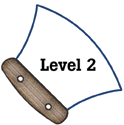|
Procedure
Students will:
-
Create a container to hold an ice cube. (Have a variety of materials
available for the students to choose from, including, paper, cotton,
cups, sticks, fur, feathers, foil, styrofoam, tape, glue, and other
materials.)
-
Put an ice cube inside the container; place it in the designated
spot.
-
Check the ice cubes as necessary; record observations in a journal.
-
Compare results with other students in class.
-
Discuss the properties of insulators and conductors.
Reflection and
Revision
Which containers worked best as insulators? Describe one change you
would make to your container to make it work better. How will this change
make the container better?
|
|
Levels of Performance
|
|
|
Student work
is complete and shows detailed evidence of the transfer and extension of
knowledge related to heat flow. Journal contains evidence of the transfer
or extension of knowledge related to heat flow. Journal contains observations
of the melting ice cube. Student designs and constructs a container that
slows the progress of melting, and describes changes that would improve
the container. |
|
|
Student work
is mostly complete and shows detailed observations of the melting ice cube.
Student designs and constructs a box that prevents the ice cube from melting,
and describes and explains in detail changes that would improve the container. |
Stage 2

 |
Student work
may be incomplete and shows limited evidence of knowledge related to heat
flow. Journal contains incomplete observations of the melting ice cube.
Student work may show evidence of skilled craftsmanship but the box design
does little to slow the progress of melting. Student may describe changes
to the container that would not alter its insulating capabilities. |
Stage 1
 |
Student work
is mostly incomplete, inappropriate, shows little evidence of craftsmanship
or knowledge related to insulating abilities of materials. |


